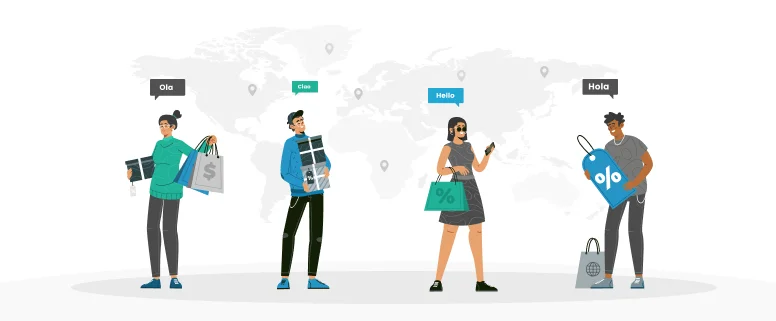In 2025, shopping is no longer just a mundane affair; it’s now a real-time, engaging experience thanks to shoppertainment. E-commerce has moved from mere transactions to interactive events that combine entertainment with shopping. Dubbed shoppertainment, this trend combines a plethora of formats, including live streams, influencer content, product reveals, and digital storytelling, into an experiential event with greater audience engagement. It’s not just clicking a “buy” button; it’s about being part of a moment.
For this global trend to work effectively and cross borders, language translation and culture go hand in hand. The visuals and formats can grab attention, but what can keep global consumers engaged is the content speaking to them both literally and emotionally. This is where translation and localization come into play. Brand success in shoppertainment relies not only on what you sell but also on how well you connect.
Table of Content
- The Importance of Translation and Localization in Shoppertainment
- The Role of AI in Translation and Localization
- Key Strategies for Success in Shoppertainment Localization
- Challenges to Address
- The Future of Shoppertainment Localization
- Multilingual Virtual Influencers and Avatars Powered by AI
- Real-Time Emotion Tracking to Adapt Content During Streams
- Hyper-Localized Campaigns Targeting Micro-Regions or Dialects
- Voice Cloning for Dubbing Influencers in Other Languages While Preserving Tone
- A New Era of E-commerce Innovation
- Conclusion
The Importance of Translation and Localization in Shoppertainment
Improved Customer Trust and Engagement
Nothing builds trust faster than speaking the customer’s language. According to studies, consumers are much more likely to buy something when product information is disclosed in their mother tongue. Because of shoppertainment’s spontaneous and emotional world, it is more important to be fluent in the audience’s language, ensuring clarity much like communication handled by teams.
Localization involves much more than translating. The goal is to adapt tone, context, idioms, and nonverbal communication according to the needs and expectations of the culture. A product joke that is funny in the United States can not work at all in Japan without a change of context. Localization ensures the core message survives and thrives across language barriers, creating an emotional connection to the brand.
Optimized Live Interactions
One of the biggest attractions of shoppertainment lies in its interactive capabilities in real time. The viewers can ask questions, comment, and receive instant feedback while tempting them into making a purchase decision. However, if these live activities are not multilingual, the effectiveness of a global engagement is compromised.
Multilingual capabilities such as real-time translation tools, subtitled streams, and localized chat interfaces help make live sessions more inclusive. Translation bots powered by AI do help with that, but they usually require human oversight for retaining cultural sensitivity. When every viewer feels seen and heard, engagement and conversions take place.
SEO and Discoverability
With visibility being the only way to stand out from other digital platforms, good shoppertainment content can be recognizable by its respective audience and, therefore, requires understanding how audiences search for stuff.
What one country describes as sneakers could have been better tagged as trainers in another country. Therefore, keywords, hashtags, and metadata all require their local SEO strategies. This close collaboration between translation teams and digital marketers ensures that all product listings, video titles, and in-stream tags are optimized for localized search behavior, whether on Google, YouTube, or TikTok, or local platforms such as Yandex or Naver.
Product Descriptions and Visual Content
In shoppertainment, storytelling is as crucial as showcasing. The story of a product, in words and vision, goes far toward affecting purchase decisions. Product description localization is essential, not only for correctness but also for emotional impact. A skincare product in South Korea may emphasize “whitening,” whereas in the West, the emphasis may be on “brightening” or “radiance.”
Conversely, visuals shown in one country can easily be unsuitable in another. Models, colors, gestures, and settings can all require cultural considerations. On-screen graphic translations, localized subtitles, and region-cued demonstration styles all help in providing a seamless and inclusive viewer experience.
The Role of AI in Translation and Localization
Generative AI is revolutionizing translation, particularly in shoppertainment, where speed and scale matter most. AI tools can create live subtitles, auto-translate comments, and enable multilingual chatbots during livestream events in real time. These allow brands to get stuff out in the market more quickly and to increase accessibility.
But AI has its limitations. It has difficulty understanding sarcasm, slang terms, idioms, and cultural nuances. A literal translation can be correct linguistically, but contextually it can be misleading or offensive.
The most effective shoppertainment strategies combine human and AI resources in 2025. Artificial intelligence will guarantee scalability; however, human localization specialists will address all cultural nuances. This increased level of scrutiny guarantees high-quality and culturally relevant content.
Key Strategies for Success in Shoppertainment Localization
Use Native-Speaking Hosts and Influencers
Local personalities add credibility and relatability. Trust begins to form when viewers see someone who looks like them, speaks their language, and understands their values. Regional influencers do not just attract followers; they understand what style of content their audience appreciates. Choosing a reliable language service provider makes your shoppertainment campaign feel real and authentic.
Localize Scripts and Storylines
A script, product benefits, and calls to action (CTAs) form an integral part of the preparation and localization. Even the call, such as click here to buy now, can be effective in English but may need additional persuasive or formal phrasing in other cultures.
The storyline structure can be different by region. There are people living in some cultures who can prefer humor and informality, while others can respond to data and testimonials. So, you have to be mindful about cultural differences and consumer behavior.
Adapt Payment and Delivery Options
Localization does not refer to language only, but to the entire journey. Your beautifully translated stream can have no effect if the checkout page is not built for local currencies or preferred payment methods, as that can greatly decrease the conversion. Every region must have specific settings for:
- Currency display
- Payment gateways (e.g., Alipay, Paytm, Klarna)
- Shipping methods
- Return policies
Implement Region-Specific Promotions
Synchronization of your promotions with regional holidays, seasons, and events can make your campaigns more effective. Lunar New Year promotions in China, Singles’ Day offers in Southeast Asia, and Black Friday events in North America are examples that concentrate on implementing localized offers, enhancing cultural buying behavior, and inducing the customers’ sense of urgency.
Conduct Cultural Testing and Linguistic QA
Test localized shoppertainment prototypes with a focus group or local market team ahead of launch. Cultural testing provides an opportunity to discover potential pitfalls: symbols, phrases, or gestures that can be misinterpreted. And linguistic QA guarantees that every translation is loyal to and communicates the same message with clarity and tone. Forgoing this step can result in an embarrassing and possibly costly blunder.
- Higher Conversion Rates: Consumers can feel inclined to complete the purchase process after feeling understood and appreciated.
- Stronger Brand Reputation: Cultural sensitivity conveys professionalism and respect, allowing the brand to present itself as credible.
- Wider Market Penetration: Language barriers can mean millions of prospects who never get a chance to be within the scope of your business.
- Improved Return on Investment: This process requires heavy investment, but a return appears worthwhile with better customer retention, repeat purchases, and efficient marketing.
Challenges to Address
Inconsistent Brand Voice
Having a consistent brand voice across languages and cultures is one of the more pressing issues in global shoppertainment. Brands have been known to scale at a rapid pace using machine translation tools, but without proper human checks, this may prove detrimental. For example, an English light-hearted and witty tone can be rendered stiff, overly formal, or culturally unwanted in another language. Such a disconnect can either confuse or alienate certain audiences, ultimately failing to keep the emotional appeal of your content intact. Your brand’s personality must feel equally loud in Tokyo as it does in New York or Berlin.
Time Zone Conflicts
The requirement of instantaneous engagement is at the core of shoppertainment, and this becomes increasingly tangled when you consider a worldwide audience. Different regions have different peak hours for shopping, social media usage, and video consumption. While it’s 2 a.m. in your target market, your live session can show little viewership or interaction. This not only comes with diminished sales but also makes the real-time energy of shoppertainment less appealing. Brands must balance feasibility against local viewer habits to retain momentum in key markets.
Team Coordination
Launching and managing localized campaigns across countries is a task that requires the involvement of all departments across various regions. The marketing team must work with translators, video producers, product managers, and local influencers to help in getting the message right. Misalignment in areas such as delayed content, mismatched cultural cues, or inconsistent promotional efforts can negatively impact the campaign. The absence of coordination internally can kill a beautiful project. This is more so in synchronizing promotional calendars, platform choice, and influencers’ partnerships across countries.
Smart Solutions for Global Scaling
To tackle these challenges, brands should think of structured solutions. Hiring regional managers guarantees that there is someone on the ground who understands the local audience and makes real-time decisions. Using scheduling platforms like StreamYard or Restream allows brands to work better across time zones by having pre-recorded content scheduled for airing at prime local hours. Finally, a strongly developed brand style guide available in multiple languages keeps tone, terminology, and visual element consistency regardless of who is translating or creating content. Together, these tools and strategies offer an audience-oriented approach to scale shoppertainment around the world.
The Future of Shoppertainment Localization
There will be a huge demand for personalized, immersive, and multilingual shopping experiences as we move further into the digital decade. Consumers today expect more than just static, generic content—they are looking for interactive experiences tailored to their language, culture, and emotions. In an industry that is changing dynamically, localization is no longer just a nice-to-have; it is a competitive necessity. The following are innovations that are writing the next chapter of shoppertainment:
Multilingual Virtual Influencers and Avatars Powered by AI
The emergence of AI-enabled virtual influencers is a global marketing powerhouse. They can be localized to speak multiple languages, acquire cues of cultural nuance, and appeal to different audiences in various regions. Using NLP and ML techniques, these avatars can recommend products, entertain users through livestreams, and respond in real-time to customer inquiries. The scalability and customizability of digital humans provide unique advantages to brands wishing to maintain historically consistent global identities while building deep and authentic connections with their local markets.
Real-Time Emotion Tracking to Adapt Content During Streams
Smart technologies that respond in real-time with emotion-detection techniques are now meaningfully evolving livestream shopping experiences. AI systems, with facial recognition, voice analysis, and behavioral cues, can measure viewer responses and configure their content appropriately, whether by resizing the tone of the host, shifting focus from one item to another, or inserting local humor within the comments. Thus, this height of emotional personalization can improve engagement and conversion rates and generate revenue by allowing brands to create hyper-relevant, immersive shopping experiences for each audience.
Hyper-Localized Campaigns Targeting Micro-Regions or Dialects
Hyper-personalization focuses on tailoring content to micro-regions or dialects so that your messages feel personal and culturally aligned at a granular level. In fact, brands nowadays tend to develop campaigns geared not just to a country but to specific provinces, cities, or lesser communities. A personal touch is created in the messages by using local influencers, festivals, humor, and preferences; this innate familiarity generates a tremendous trust factor among customers and helps build customer loyalty and retention. This factor is all too powerful in some diverse markets like India, China, and Latin America.
Voice Cloning for Dubbing Influencers in Other Languages While Preserving Tone
Voice cloning technology lets dubbing, such as live or recorded shoppertainment content, into multiple languages while maintaining the unique tone, style, and emotional expression of the speaker. In this way, an influencer can still possess their brand identity and charisma to speak to audiences in other regions. Voice cloning keeps it real, as well as upholding the strong emotional connection with viewers, no matter their native language.
A New Era of E-commerce Innovation
The businesses that invest in localization infrastructure supported by both human and technological means are destined to set the next wave of global e-commerce innovation. Those brands that create unique experiences that are deeply personalized, culturally relevant, and emotionally engaging can set themselves apart as competition tightens. No longer is localization simply translation; it is the creation of meaningful connections that engender loyalty, trust, and sustained growth in every market touched.
Conclusion
Shoppertainment in 2025 is no longer just a trend. It has become a powerful and important part of online shopping all around the world. But to make shoppertainment popular in other countries, it’s not enough to have flashy videos and fun influencers. It also needs translation and localization. As shoppertainment keeps growing in online selling, the people and businesses who start using it early and seriously will stand out in the competitive business world. They can also build strong and lasting connections with customers from many different countries and achieve great success in the e-commerce business.





